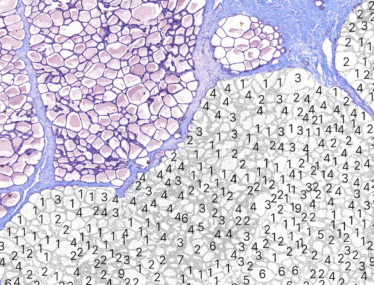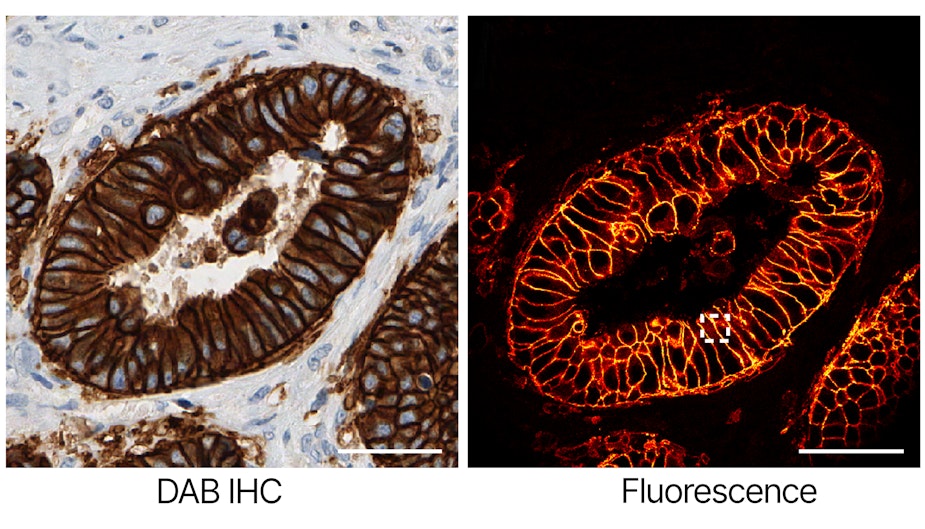Imaging by the numbers: quantitative imaging for digital pathology
By Alexander Carr

Pathology is going digital and novel quantitative imaging approaches will take diagnostic power to the next level while creating opportunities for automation in the multi-billion tissue diagnostics industry. Alexander Carr reviews steps towards quantification in 2019.
Pathology is rapidly evolving to accommodate technology at its core. Automation, digitisation and artificial intelligence analysis applied to traditional pathology imaging approaches already promise to reduce workloads and improve diagnoses in an industry that relies on human judgement to make life-changing decisions for patients.
Recent investments reflect this promise. In the UK, five new centres with the mission to enhance traditional pathology pathways with artificial intelligence were launched earlier this year backed by £50 million from the Industrial Strategy Challenge Fund [1]. Venture capitalists, too, recognise the disruptive potential of artificial intelligence to traditional pathology models as start-ups PathAI and Deeplens both secured tens of millions in funding [2,3].
But as with all applications of machine learning, consistent and highly annotated data is essential to spot trends, as discussed in another TTP blog [4]. Herein also lies the obstacle that must be overcome before digital pathology can obtain its licence to practice: many existing pathology imaging techniques do not readily produce quantitative outputs. This not only opens the door to inconsistencies in human judgement but also limits the amount of detail that can be observed and the scope for automated image analysis.
In this blog we discuss:
- Bringing pathology imaging into the age of quantification
- The benefits of quantitative imaging
- Intrinsically quantitative imaging techniques
- The changing face of digital pathology CAMPAIGNDiagnostics development
Bringing pathology imaging into the age of quantification
In response, research groups in diagnostic and computing companies are updating existing pathology imaging techniques for quantification.
Take one industry workhorse as an example. Immunohistochemistry (IHC) based on chromogenic staining (e.g. DAB) suffers from signal saturation, which limits the dynamic measurement range of the technique, as well as temperature dependence that makes quantification of biomarker levels imprecise.
In contrast, a recently introduced staining amplification method dubbed qIHC – for quantitative IHC – beats not only DAB staining but also gold-standard ELISA references in quantifying cancer biomarker levels in breast tissue [5].
And earlier this year, researchers from IBM together with ETH and University Hospital Zurich, reported that monitoring the saturating kinetics of DAB staining with standard IHC reagents enables quantitative biomarker detection in breast cancer samples [6].
Both approaches are compatible with standard brightfield slide scanners, making integration with existing pathology workflows relatively simple in principle.
The benefits of quantitative imaging
Quantitative techniques promise to eliminate biases, both conscious and unconscious, through the output of numerical metrics, rather than qualitative results, that can be directly compared to robust, predefined thresholds of clinical relevance.
Inconsistency in human judgment as well as inevitable human error can thus be minimised, and automated analysis procedures can be better implemented.
Quantitative imaging techniques will also facilitate the use of analytical tools that can identify detail that may previously have been missed to provide deeper insight and, ultimately, improved patient outcomes.

Intrinsically quantitative imaging techniques
Another range of quantitative approaches – emerging in the realm of imaging platforms and analysis companies – use fluorescence or other molecular-emissive processes instead of brightfield illumination to quantify labelled biomarkers within a sample.
In this area, problems such as photobleaching and inconsistent labelling protocols have so far hindered the widespread clinical adoption of existing fluorescent slide scanners.
But here, too, quantitative approaches are starting to gain traction as solutions to these issues appear. BioGenex, Konica-Minolta and the University of Rochester have recently reported a standardised workflow to quantify breast cancer biomarkers in human tissue samples with non-bleaching fluorescent probes [7].
Deeper insight into healthy and diseased tissue could come from combining the outputs of intrinsically quantitative imaging approaches with artificial intelligence-based image analysis, as illustrated by a new collaboration between Ultivue and Definiens.
Ultivue’s technology enables repeatable imaging of IHC slides and highly multiplexed biomarker studies with limited fluorophores [8]. Now the two companies are working together to expand the capabilities of Definiens’ image analysis to Ultivue’s fluorescence-based quantitative multiplex IHC [9].
Finally, a family of imaging approaches building on quantitative fluorescence known as Super-Resolution Microscopy have the potential to dramatically improve spatial resolution as well as quantitative sensitivity. Although adoption of Super-Resolution Microscopy is still limited due to expensive equipment and a lack of well-established analysis tools, more affordable platforms, such as that of Oxford Nanoimaging, are starting to reduce barriers to entry, even if it could be some time before these ultra-high-resolution techniques are seen in a clinical setting [10].
The changing face of digital pathology
Looking forward, quantitative imaging promises to remove inconsistencies due to protocols and individual judgement calls. The first steps towards integration of quantification in tissue-based pathology will likely be artificial intelligence aimed at augmentation of professionals, reducing workloads by intelligent stratification of tissue samples into high and low risk categories before human analysis. Beyond this, the first fully automated diagnosis from tissue samples may not be far away as AI diagnostic tools are starting to gain FDA approval and CE certification [11-13].
From completely new approaches for biomarker detection to automated imaging platforms, opportunities related to quantitative imaging are numerous as pathology embraces the augmentation of human judgement. The availability of consistent data in formats that are readily compatible with quantification will also facilitate increased use of big data analysis methods to further improve patient outcomes.
Quantitative imaging has the disruptive potential to streamline all of tissue pathology – which should be welcome, seeing that human pathologists are already a dwindling and overworked resource.
Diagnostics | Life Science | Medical Imaging | Digital Health | Healthcare Blogs | Healthcare Case Studies
References
01. Five new AI centres of excellence to be established across UK
06. Quantitative microimmunohistochemistry for the grading of immunostains on tumour tissues
07. A Novel, Quantitative Immunohistochemistry Method enabled by BioGenex IHC System
08. Multiplex IHC staining and analysis in a single work day
010. The Nanoimager is the complete package in super-resolution microscopy
011. AI diagnostic tool for pneumothoraces approved by FDA
012. FDA approves GE Healthcare’s AI algorithms for chest x-rays
013. FDA grants ‘breakthrough’ designation to ultrasound AI product
014. STED Super-Resolution Microscopy of Clinical Paraffin-Embedded Human Rectal Cancer Tissue



